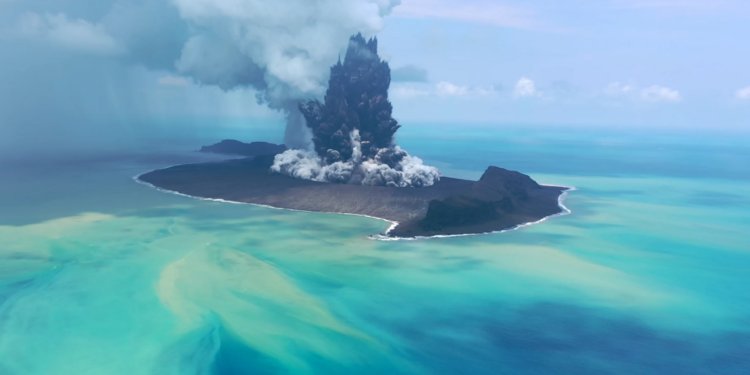In January 2022, a massive underwater volcano called Hunga Tonga suddenly erupted and shot so much water into the upper atmosphere that levels in the stratosphere rose suddenly by at least 10%.
It was a genuine one in 100, even 200 year event and was reasonably expected to produce temporary weather changes around the globe.
Sure enough, subsequent temperatures showed a 0.3-0.4°C upward spike.
Needless to say, the Net Zero fanatics blamed it on humans by increasing the trace gas carbon dioxide.
.
Today the Daily Sceptic can give wider publicity to sensational recent findings that suggest Hunga Tonga was the main culprit in producing the recent spike.
The scientists directly link a dramatic cooling in the upper atmosphere of between 0.5-2°C to Hunga Tonga.
It is generally held that there is an anti-correlation between the lower and upper atmosphere and cooling at the top produces warming at the bottom due to a number of complex atmospheric processes.
.
Hunga Tonga was an unusual volcanic eruption since it produced few dust particulates that usually cool the surface.
Two recent land-based eruptions, El Chichon and Pinatubo, caused a temporary downward spike of around 0.5°C.
The team of Colorado-based scientists found that the Hunga Tonga cooling was “comparable in magnitude” to the stratospheric warming caused by the two surface volcanoes in 1982 and 1991.
The scientists reported “good agreement of observations with chemistry-climate model simulations”. “Cooling is mainly due to Hunga Tonga H2O [water] impacts,” they state.
.
This is dramatic stuff. It appears to promote Hunga Tonga as the prime cause in explaining the recent spike in temperatures.
Indeed it could be concluded that the temperature rise should have been a little higher, if the effects of a recent strong El Niño natural oscillation are included.
Satellite observations, confirmed by computer analysis, shows stratospheric cooling of 0.5°C to 1°C in the middle and upper stratosphere during 2022 through middle 2023, followed by stronger reductions of 1°C to 2°C in the mesosphere after the middle of 2023, note the scientists.
Last year, two distinguished atmospheric scientists observed the anti-correlation between the higher and lower atmosphere and suggested the lower stratosphere cooled by approximately two degrees per degree of warming nearer the surface.
Where the troposphere has been anomalously warming, the lower stratosphere has been anomalously cooling “and vice versa”, note the scientists.
.
In the lower stratosphere at 20 kilometer, the water injection due to Hunga-Tonga is extremely small.
That water would immediately freeze on the dry air molecules and CO2 molecules.
Any sunlight would be refracted or reflected by the ice crystals.
Any photons emitted by the ice crystals would have longer than 15 micrometer wavelengths, they could not be absorbed by CO2 molecules at lower elevations, but they could be absorbed by WV molecules at lower elevations
It is not realistic to expect air at 20 km or higher would be cooled by the extremely small Hunga-Tonga water injection
The atmosphere heat content/m^3, aka Enthalpy, is 358 kJ / m^3 near the surface, decreases to 19.5 KJ / m^3 at 20 km.
See complete table in URL
https://www.windtaskforce.org/profiles/blogs/natural-forces-cause-periodic-global-warming
.

.
Drs. Happer and van Wijngaarden
.
During cloudy skies, there is warming, due to downward IR radiation from cloud bottoms at about 340 W/m^2
During clear skies, there is about 30% less warming, due to upward IR radiation at about 260 W/m^2, primarily from the thermal IR radiation of water vapor and CO2
.
If cloud cover increases from 60 to 65%, the upward IR radiation (cooling) from earth surface would decrease by (0.40 - 0.35) x 260 = 13 W/m^2, and downward IR radiation (warming) from cloud bottoms would increase by (0.65 – 0.60) x 340 = 17 W/m^2, for a net warming increase of 30 W/m^2
Because cloud cover increases of 5% or more. routinely occur, such as during stronger El Ninos, over time-scales of a few years, the role of CO2 within the greenhouse effect is insignificant, if not irrelevant.
Cloud cover changes are the only plausible explanation for most of the modest “secular” warming of the past two centuries. Together with ocean current fluctuations (see below URLs), cloud cover changes are also the only physical mechanism that could account for fluctuating temperature changes with time scales of a few years.
Based on fundamental physics, one should expect some warming from increasing CO2. But this warming will be too small to account for what has been observed.
Cloud cover changes provide the only rational explanation that does not violate basic physics.

You need to be a member of Citizens' Task Force on Wind Power - Maine to add comments!
Join Citizens' Task Force on Wind Power - Maine